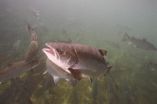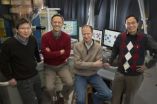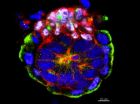(Press-News.org) Atlantic salmon production could be boosted by a new technology that will help select the best fish for breeding.
The development will enable salmon breeders to improve the quality of their stock and its resistance to disease.
A chip loaded with hundreds of thousands of pieces of DNA – each holding a fragment of the salmon's genetic code – will allow breeders to detect fish with the best genes.
It does so by detecting variations in the genetic code of each individual fish – known as single nucleotide polymorphisms (SNPs). These variations make it possible to identify genes that are linked to desirable physical traits, such as growth or resistance to problematic diseases, for example sea lice infestations.
Salmon breeders will be able to carry out the test by taking a small sample of fin tissue.
The chip carries over twenty times more genetic information than existing tools. Similar chips have already transformed breeding programmes for land-farmed livestock including cattle and pigs.
Salmon farming contributes around half a billion pounds to the UK economy each year and provides healthy, high quality food. Worldwide, approximately 1.5 million tonnes of Atlantic salmon are produced every year.
Scientists from the University of Edinburgh's Roslin Institute and Edinburgh Genomics initiative developed the chip with researchers from the Universities of Stirling and Glasgow. They worked with industrial partners Affymetrix UK and Landcatch Natural Selection. The work was funded by the UK's innovation agency – the Technology Strategy Board – and the Biotechnology and Biological Sciences Research Council.
The chip is highlighted in a study published today in the journal BMC Genomics and it will be available to breeders and farmers from March 2014.
Dr Ross Houston, of The Roslin Institute, said: "Selective breeding programmes have been used to improve salmon stocks since the 1970s. This new technology will allow the best breeding fish to be selected more efficiently and accurately, particularly those with characteristics that are difficult to measure such as resistance to disease"
Dr Alan Tinch, director of genetics at Landcatch Natural Selection, said: "This development takes selective breeding programmes to a whole new level. It is an extension to the selective breeding of salmon allowing more accurate identification of the best fish to create healthier and more robust offspring."
INFORMATION: END
Genetic chip will help salmon farmers breed better fish
2014-02-14
ELSE PRESS RELEASES FROM THIS DATE:
Discovery may help to explain mystery of 'missing' genetic risk
2014-02-14
A new study could help to answer an important riddle in our understanding of genetics: why research to look for the genetic causes of common diseases has failed to explain more than a fraction of the heritable risk of developing them.
Susceptibility to common diseases is believed to arise through a combination of many common genetic variants that individually slightly increase the risk of disease, plus a smaller number of rare mutations that often carry far greater risk.
However, even when their effects are added together, the genetic variants so far linked to common ...
Mixed genes
2014-02-14
This news release is available in German. When individuals from different groups interbreed, their offspring's DNA becomes a mixture of the DNA from each admixing group. Pieces of this DNA are then passed along through subsequent generations, carrying on all the way to the present day. Researchers from the Max Planck Institute for Evolutionary Anthropology in Leipzig, Germany, Oxford University and University College London (UCL) have now produced a global map detailing the genetic histories of 95 different populations across the world, spanning the last four millennia.
The ...
Study highlights indigenous response to natural disaster
2014-02-14
DENVER (Feb. 13, 2014) – When a tsunami struck American Samoa in 2009, indigenous institutions on the islands provided effective disaster relief that could help federal emergency managers in similar communities nationwide, according to a study from the University of Colorado Denver and the University of Hawaii at Manoa.
The study found that following the tsunami, residents of the remote U.S. territory in the South Pacific relied on Fa'aSamoa or The Samoan Way, an umbrella term incorporating a variety of traditional institutions governing the lives of its citizens.
"We ...
Berkeley Lab researchers at AAAS 2014
2014-02-14
Can more accurate climate models help us understand extreme weather events? Can we use
synthetic biology to create better biofuels? These questions, and the ongoing search for Dark
Matter and better photovoltaic materials, are just some of the presentations by Lawrence
Berkeley National Lab researchers at this year's AAAS meeting. Here's a quick look at Berkeley
Lab@AAAS:
Friday, Feb. 14
1:00-2:30
Opportunities for New Materials in
Photovoltaics (Toronto Room, Hyatt Regency)
Ramamoorthy Ramesh
The
Department of Energy's ...
Superconductivity in orbit: Scientists find new path to loss-free electricity
2014-02-14
UPTON, NY—Armed with just the right atomic arrangements, superconductors allow electricity to flow without loss and radically enhance energy generation, delivery, and storage. Scientists tweak these superconductor recipes by swapping out elements or manipulating the valence electrons in an atom's outermost orbital shell to strike the perfect conductive balance. Most high-temperature superconductors contain atoms with only one orbital impacting performance—but what about mixing those elements with more complex configurations?
Now, researchers at the U.S. Department of ...
Rewriting the text books: Scientists crack open 'black box' of development
2014-02-14
We know much about how embryos develop, but one key stage – implantation – has remained a
mystery. Now, scientists from Cambridge have discovered a way to study and film this 'black box'
of development. Their results – which will lead to the rewriting of biology text books worldwide
– are published in the journal Cell. Embryo development in mammals occurs in two phases.
During the first phase, pre-implantation, the embryo is a small, free-floating ball of cells
called a blastocyst. In the second, post-implantation, phase the blastocyst embeds itself in the
mother's ...
A role of glucose tolerance could make the adaptor protein p66Shc a new target for cancer and diabetes
2014-02-14
[TORONTO,Canada, Feb 18, 2014] – A protein that has been known until recently as part of a complex communications network within the cell also plays a direct role in regulating sugar metabolism, according to a new study published on-line in the journal Science Signaling (February 18, 2014).
Cell growth and metabolism are tightly controlled processes in our cells. When these functions are disturbed, diseases such as cancer and diabetes occur. Mohamed Soliman, a PhD candidate at the Lunenfeld Tanenbaum Research Institute at Mount Sinai Hospital, found a unique role for ...
IBEX research shows influence of galactic magnetic field extends beyond our solar system
2014-02-14
In a report published today, new research suggests the enigmatic "ribbon" of energetic
particles discovered at the edge of our solar system by NASA's Interstellar Boundary Explorer (IBEX)
may be only a small sign of the vast influence of the galactic magnetic field.
IBEX researchers have sought answers about the ribbon since its discovery in 2009. Comprising
primarily space physicists, the IBEX team realized that the galactic magnetic field wrapped around
our heliosphere — the giant "bubble" that envelops and protects our solar system — appears to
determine the orientation ...
Rebuilding the brain after stroke
2014-02-14
DETROIT – Enhancing the brain's inherent ability to rebuild itself after a stroke with molecular
components of stem cells holds enormous promise for treating the leading cause of long-term
disability in adults.
Michael Chopp, Ph.D., Scientific Director of the Henry Ford Neuroscience Institute, will present
this approach to treating neurological diseases Thursday, Feb. 13, at the American Heart
Association's International Stroke Conference in San Diego.
Although most stroke victims recover some ability to voluntarily use their hands and other body
parts, half are ...
Amidst bitter cold and rising energy costs, new concerns about energy insecurity
2014-02-14
February 13,2014 --With many regions of the country braced by an unrelenting cold snap, the problem of energy insecurity continues to go unreported despite its toll on the most vulnerable. In a new brief, researchers at Columbia University's Mailman School of Public Health paint a picture of the families most impacted by this problem and suggest recommendations to alleviate its chokehold on millions of struggling Americans. The authors note that government programs to address energy insecurity are coming up short, despite rising energy costs.
Energy Insecurity (EI) is ...




